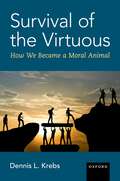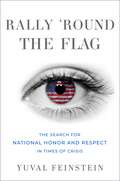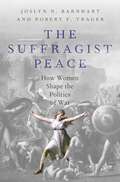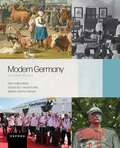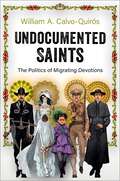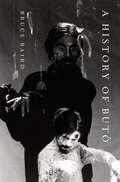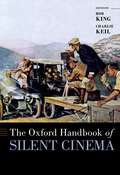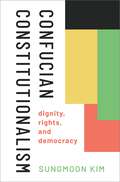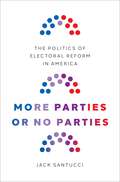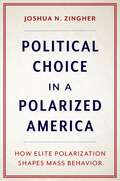- Table View
- List View
Survival of the Virtuous: The Evolution of Moral Psychology
by Dennis L. KrebsDo good guys finish last? Did we evolve to look out for number one? Are we bad by nature? At first glance, the theory of evolution seems to imply that all organisms are evolved to be selfish. In this book, evolutionary psychologist Dennis Krebs explains how virtuous behaviors such as altruism, justice, honesty, loyalty, self-control, purity, and respect for authority, have evolved in humans and other species. He argues that the key to solving puzzles of morality--such as what it is, how we acquire moral traits, why we sometimes behave badly, and how we make moral decisions--lies in figuring out what adaptive functions moral traits served in early human environments and how they are influenced by social learning, culture, and strategic social interactions in the modern world. Arguing that the primary function of virtuous behaviors is to enable individuals to advance their own interests and examining the moral decision-making mechanisms that evolved to serve these functions, this book considers the "new brain" mechanisms that are unique to humans and "old brain" mechanisms that we share with other species, illuminating how these work in conjunction with each other to guide our moral choices. Survival of the Virtuous is accessibly written for academic and scholarly readers interested in understanding how moral traits evolved in the human species.
Rally 'round the Flag: The Search for National Honor and Respect in Times of Crisis (Oxford Studies in Culture and Politics)
by Yuval FeinsteinAn extensive investigation of the rally-round-the-flag phenomenon of public opinion in the United States during wars and security crises. The "rally-round-the-flag" phenomenon in the United States is characterized by a sudden and sharp increase in the public approval rating of the sitting US president in response to a war or security crisis. While relatively uncommon, these moments can have a serious impact on policymaking as politicians might escalate a conflict abroad or restrict civil liberties at home. What, then, are the conditions and processes through which rallies have emerged? In Rally 'round the Flag, Yuval Feinstein revisits the phenomenon to answer this question. He examines both the conditions under which rally periods have emerged in the US and the processes that have generated these rallies to introduce a novel rally theory. Drawing on an original data set of conflicts covering 1950 to 2020 and survey data, Feinstein shows that the rally-round-the-flag effect is not an automatic public reaction to international conflicts. Rather, it is a rare event that emerges only under circumstances that lead most Americans to believe it is necessary to take military action to maintain or restore collective honor and gain the respect of other nations. He further attributes public opinion shifts during rally periods to nationalist emotions that people experience when they believe that the president's actions effectively protect the nation's honor and international prestige. Identifying the unique sets of conditions for the emergence of rallies, Rally 'round the Flag offers the most extensive investigation of this public opinion phenomenon and proposes future directions to research the topic for both the United States and other countries.
Rally 'round the Flag: The Search for National Honor and Respect in Times of Crisis (Oxford Studies in Culture and Politics)
by Yuval FeinsteinAn extensive investigation of the rally-round-the-flag phenomenon of public opinion in the United States during wars and security crises. The "rally-round-the-flag" phenomenon in the United States is characterized by a sudden and sharp increase in the public approval rating of the sitting US president in response to a war or security crisis. While relatively uncommon, these moments can have a serious impact on policymaking as politicians might escalate a conflict abroad or restrict civil liberties at home. What, then, are the conditions and processes through which rallies have emerged? In Rally 'round the Flag, Yuval Feinstein revisits the phenomenon to answer this question. He examines both the conditions under which rally periods have emerged in the US and the processes that have generated these rallies to introduce a novel rally theory. Drawing on an original data set of conflicts covering 1950 to 2020 and survey data, Feinstein shows that the rally-round-the-flag effect is not an automatic public reaction to international conflicts. Rather, it is a rare event that emerges only under circumstances that lead most Americans to believe it is necessary to take military action to maintain or restore collective honor and gain the respect of other nations. He further attributes public opinion shifts during rally periods to nationalist emotions that people experience when they believe that the president's actions effectively protect the nation's honor and international prestige. Identifying the unique sets of conditions for the emergence of rallies, Rally 'round the Flag offers the most extensive investigation of this public opinion phenomenon and proposes future directions to research the topic for both the United States and other countries.
The Suffragist Peace: How Women Shape the Politics of War
by Robert F. Trager Joslyn N. BarnhartA deep and historical examination of how the political influence of women at the ballot box has shaped the course of war and peace. In the modern age, some parts of the world are experiencing a long peace. Nuclear weapons, capitalism and the widespread adoption of democratic institutions have been credited with fostering this relatively peaceful period. Yet, these accounts overlook one of the most dramatic transformations of the 20th century: the massive redistribution of political power as millions of women around the world won the right to vote. Through gripping history and careful reasoning, this book examines how the political influence of women at the ballot box has shaped war and peace. What would a world ruled by women look like? For more than a hundred years, conventional wisdom held that women's votes had little effect. That view is changing - it turns out that women voters had a profound effect on the world we know and in ways we hardly understand. A world ruled by women's voices is a world that is less willing to fall in love with war as a noble end in itself, less prone to lapse into violence for the sake of maintaining an image. In other words, it is the world we live in now, more so than we have ever realized.
The Suffragist Peace: How Women Shape the Politics of War
by Robert F. Trager Joslyn N. BarnhartA deep and historical examination of how the political influence of women at the ballot box has shaped the course of war and peace. In the modern age, some parts of the world are experiencing a long peace. Nuclear weapons, capitalism and the widespread adoption of democratic institutions have been credited with fostering this relatively peaceful period. Yet, these accounts overlook one of the most dramatic transformations of the 20th century: the massive redistribution of political power as millions of women around the world won the right to vote. Through gripping history and careful reasoning, this book examines how the political influence of women at the ballot box has shaped war and peace. What would a world ruled by women look like? For more than a hundred years, conventional wisdom held that women's votes had little effect. That view is changing - it turns out that women voters had a profound effect on the world we know and in ways we hardly understand. A world ruled by women's voices is a world that is less willing to fall in love with war as a noble end in itself, less prone to lapse into violence for the sake of maintaining an image. In other words, it is the world we live in now, more so than we have ever realized.
Our Least Important Asset: Why the Relentless Focus on Finance and Accounting is Bad for Business and Employees
by Peter CappelliA comprehensive and insightful look at the modern workplace and how employees are managed, where the new approach is driven by the quirks of financial accounting to the detriment of employees and the long-term success of the organization. Real wages have stagnated or declined for most workers, job insecurity has increased, and retirement income is uncertain. Hours of work for white collar employees have increased steadily, opportunities for advancement have withered, and evidence of the negative effects of workplace stress on health continues to accumulate. Why have jobs gotten so much worse? As Peter Cappelli argues, these issues are not a result of companies trying to be cost effective. They stem from the logic of financial accounting--the arbiter for determining whether a company is maximizing shareholder value--and its fundamental flaws in dealing with human capital. Financial accounting views employee costs as fixed costs that cannot be reduced and fails to account for the costs of bad employees and poor management. The simple goal of today's executives is to drive down employment costs, even if it raises costs elsewhere. In Our Least Important Asset, Cappelli argues that the financial accounting problem explains many puzzling practices in contemporary management--employers' emphasis on costs per hire over the quality of hires, the replacement of regular employees with "leased" workers, the shift to unlimited vacations, and the transition of hiring responsibilities from professional recruiters to more expensive line managers. In the process, employers undercut all the evidence about what works to improve the quality, productivity, and creativity of workers. Drawing on decades of experience and research, Cappelli provides a comprehensive and insightful critique of the modern workplace where the gaps in financial accounting make things worse for everyone, from employees to investors.
Our Least Important Asset: Why the Relentless Focus on Finance and Accounting is Bad for Business and Employees
by Peter CappelliA comprehensive and insightful look at the modern workplace and how employees are managed, where the new approach is driven by the quirks of financial accounting to the detriment of employees and the long-term success of the organization. Real wages have stagnated or declined for most workers, job insecurity has increased, and retirement income is uncertain. Hours of work for white collar employees have increased steadily, opportunities for advancement have withered, and evidence of the negative effects of workplace stress on health continues to accumulate. Why have jobs gotten so much worse? As Peter Cappelli argues, these issues are not a result of companies trying to be cost effective. They stem from the logic of financial accounting--the arbiter for determining whether a company is maximizing shareholder value--and its fundamental flaws in dealing with human capital. Financial accounting views employee costs as fixed costs that cannot be reduced and fails to account for the costs of bad employees and poor management. The simple goal of today's executives is to drive down employment costs, even if it raises costs elsewhere. In Our Least Important Asset, Cappelli argues that the financial accounting problem explains many puzzling practices in contemporary management--employers' emphasis on costs per hire over the quality of hires, the replacement of regular employees with "leased" workers, the shift to unlimited vacations, and the transition of hiring responsibilities from professional recruiters to more expensive line managers. In the process, employers undercut all the evidence about what works to improve the quality, productivity, and creativity of workers. Drawing on decades of experience and research, Cappelli provides a comprehensive and insightful critique of the modern workplace where the gaps in financial accounting make things worse for everyone, from employees to investors.
Blue-Footed Boobies: Sibling Conflict and Sexual Infidelity on a Tropical Island
by Hugh DrummondIn Blue-Footed Boobies, Hugh Drummond presents a lifetime field study of one of the planet's most charismatic and observable birds, focused on two themes of human relevance: aggressive competition between siblings and monogamous pair-bonding combined with frequent infidelity. In an account peppered with research anecdotes, he immerses readers in a bustling blue-footed booby colony where social manipulation and life-and-death dramas are the stuff of family life. Here, dominant elder chicks prefer to bully their siblings into abject submission rather than killing them and younger siblings' susceptibility to subordination is an evolved ability. The narrative expands to survey the colorful strategies used by young birds and mammals to compete with siblings ruthlessly, with restraint or with courtly manners, scrutinize the role of parents in sibling conflict, and assess the lifetime impacts of bullying on those that survive. Next, a compelling eye-witness account of monogamous partnerships in blue-foots reveals a world disturbingly familiar to humans. After displaying their beauty and physical prowess to each other, females and males select partners and commit to months of relentless parental care, sharing duties and making decisions jointly. Half of them renew their bond the following year, and renewers are more efficient and successful than first-time partners. But colonies of bonded blue-foot pairs are hotbeds of infidelity! Nearly all females and males carry on semi-secret liaisons with 1-3 neighbors, roughly one third of them copulate repeatedly with those extra partners, and one in ten males ends up caring for another male's chick. Countermeasures include surveillance, aggression and partner-switching, and males unsure of paternity sometimes resort to infanticide. Drummond discusses a panoply of plausible biological functions of infidelity. Sibling competition and sexual conflict are widespread in animal species in which two partners raise contemporaneous offspring together, and notorious in humans. In the final chapter Drummond argues for a common evolutionary cause in the blue-foot and human lineages, despite the psychology of their behavior being quite different: whereas boobies thoughtlessly follow routines of predictable actions, humans experience inclinations and urges they can implement in diverse ways, or choose to veto.
Blue-Footed Boobies: Sibling Conflict and Sexual Infidelity on a Tropical Island
by Hugh DrummondIn Blue-Footed Boobies, Hugh Drummond presents a lifetime field study of one of the planet's most charismatic and observable birds, focused on two themes of human relevance: aggressive competition between siblings and monogamous pair-bonding combined with frequent infidelity. In an account peppered with research anecdotes, he immerses readers in a bustling blue-footed booby colony where social manipulation and life-and-death dramas are the stuff of family life. Here, dominant elder chicks prefer to bully their siblings into abject submission rather than killing them and younger siblings' susceptibility to subordination is an evolved ability. The narrative expands to survey the colorful strategies used by young birds and mammals to compete with siblings ruthlessly, with restraint or with courtly manners, scrutinize the role of parents in sibling conflict, and assess the lifetime impacts of bullying on those that survive. Next, a compelling eye-witness account of monogamous partnerships in blue-foots reveals a world disturbingly familiar to humans. After displaying their beauty and physical prowess to each other, females and males select partners and commit to months of relentless parental care, sharing duties and making decisions jointly. Half of them renew their bond the following year, and renewers are more efficient and successful than first-time partners. But colonies of bonded blue-foot pairs are hotbeds of infidelity! Nearly all females and males carry on semi-secret liaisons with 1-3 neighbors, roughly one third of them copulate repeatedly with those extra partners, and one in ten males ends up caring for another male's chick. Countermeasures include surveillance, aggression and partner-switching, and males unsure of paternity sometimes resort to infanticide. Drummond discusses a panoply of plausible biological functions of infidelity. Sibling competition and sexual conflict are widespread in animal species in which two partners raise contemporaneous offspring together, and notorious in humans. In the final chapter Drummond argues for a common evolutionary cause in the blue-foot and human lineages, despite the psychology of their behavior being quite different: whereas boobies thoughtlessly follow routines of predictable actions, humans experience inclinations and urges they can implement in diverse ways, or choose to veto.
Modern Germany: A Global History
by Eric Kurlander Douglas T. McGetchin Bernd-Stefan GreweModern Germany: A Global History places Germany in a global and transnational context, while offering a broad scope of chronological and thematic coverage. The authors present German-speaking lands in relation to the rest of the world, rather than as discrete entities, bringing global and transnational linkages and interdependencies into focus.
Disruptive Technology and the Law of Naval Warfare
by James Kraska Raul PedrozoConflict at sea has been transformed by disruptive technologies, creating a dynamic and distributed operational environment that extends from the oceans to encompass warfare on land, in the air, outer space, and cyberspace. This raises choice of law decisions that include the law of naval warfare and the law of armed conflict, neutrality law, and the peacetime regimes that apply to the oceans, airspace, outer space, and cyberspace. The international law in networked naval warfare must contend with autonomous vessels and aircraft, artificial intelligence, and long-range precision strike missiles that can close the kill chain at sea and beyond. The asymmetrical use of merchant ships and blockchain shipping in naval operations, opening of the seabed as a new dimension of undersea warfare, and sophisticated attacks against submarine cables and space satellites pose new operational and legal dilemmas. Navigating this broader conception of the international law of naval warfare requires an understanding of emerging operational capabilities and concepts throughout the spectrum of conflict and the selection and integration of distinct legal regimes. This book gives readers an understanding of the discrete but overlapping legal frameworks connected to the law of naval warfare and explores related concepts of seapower and naval technology.
Disruptive Technology and the Law of Naval Warfare
by James Kraska Raul PedrozoConflict at sea has been transformed by disruptive technologies, creating a dynamic and distributed operational environment that extends from the oceans to encompass warfare on land, in the air, outer space, and cyberspace. This raises choice of law decisions that include the law of naval warfare and the law of armed conflict, neutrality law, and the peacetime regimes that apply to the oceans, airspace, outer space, and cyberspace. The international law in networked naval warfare must contend with autonomous vessels and aircraft, artificial intelligence, and long-range precision strike missiles that can close the kill chain at sea and beyond. The asymmetrical use of merchant ships and blockchain shipping in naval operations, opening of the seabed as a new dimension of undersea warfare, and sophisticated attacks against submarine cables and space satellites pose new operational and legal dilemmas. Navigating this broader conception of the international law of naval warfare requires an understanding of emerging operational capabilities and concepts throughout the spectrum of conflict and the selection and integration of distinct legal regimes. This book gives readers an understanding of the discrete but overlapping legal frameworks connected to the law of naval warfare and explores related concepts of seapower and naval technology.
Undocumented Saints: The Politics of Migrating Devotions
by William A. Calvo-QuirósUndocumented Saints follows the migration of popular saints from Mexico into the US and the evolution of their meaning. The book explores how Latinx battles for survival are performed in the worlds of faith, religiosity, and the imaginary, and how the socio-political realities of exploitation and racial segregation frame their popular religious expressions. It also tracks the emergence of inter-religious states, transnational ethnic and cultural enclaves unified by faith. The book looks at five vernacular saints that have emerged in Mexico and whose devotions have migrated into the US in the last one hundred years: Jesús Malverde, a popular bandido turned saint caudillo; Santa Olguita, an emerging feminist saint linked to border women's experiences of sexual violence; Juan Soldado, a murder-rapist soldier who is now a patron for undocumented immigrants and the main suspect in the death of an eight-year-old victim known now as Santa Olguita; Toribio Romo, a Catholic priest whose ghost/spirit has been helping people cross the border into the US since the 1990s; and La Santa Muerte, a controversial personification of death who is particularly popular among LGBTQ migrants. Each chapter contextualizes a particular popular saint within broader discourses about the construction of masculinity and the state, the long history of violence against Latina and migrant women, female erasure from history, discrimination against non-normative sexualities, and as US and Mexican investment in the control of religiosity within the discourses of immigration.
Undocumented Saints: The Politics of Migrating Devotions
by William A. Calvo-QuirosUndocumented Saints follows the migration of popular saints from Mexico into the US and the evolution of their meaning. The book explores how Latinx battles for survival are performed in the worlds of faith, religiosity, and the imaginary, and how the socio-political realities of exploitation and racial segregation frame their popular religious expressions. It also tracks the emergence of inter-religious states, transnational ethnic and cultural enclaves unified by faith. The book looks at five vernacular saints that have emerged in Mexico and whose devotions have migrated into the US in the last one hundred years: Jesús Malverde, a popular bandido turned saint caudillo; Santa Olguita, an emerging feminist saint linked to border women's experiences of sexual violence; Juan Soldado, a murder-rapist soldier who is now a patron for undocumented immigrants and the main suspect in the death of an eight-year-old victim known now as Santa Olguita; Toribio Romo, a Catholic priest whose ghost/spirit has been helping people cross the border into the US since the 1990s; and La Santa Muerte, a controversial personification of death who is particularly popular among LGBTQ migrants. Each chapter contextualizes a particular popular saint within broader discourses about the construction of masculinity and the state, the long history of violence against Latina and migrant women, female erasure from history, discrimination against non-normative sexualities, and as US and Mexican investment in the control of religiosity within the discourses of immigration.
A History of Butô
by Bruce BairdButô is rarely given the credit it deserves as one of the most innovative forms of dance and theater that emerged throughout the 20th century. One of the world's leading experts on the form, author Bruce Baird offers in The History of Butô a new account of a crucial and influential performance art of the latter half of the 20th century. Tracing the performances and techniques of ten of the most important names in the first and second generation of butô, including Hijikata Tatsumi, Maro Akaji, Carlotta Ikeda, and Kobayashi Saga, as well as following its migration abroad to France and elsewhere, The History of Butô puts on display the creativity of the founders as well as the variety of directions taken by subsequent dancers. In addition, this book places these choreographer/dancers at the center of many of our time's most important issues, demonstrating the importance and relevance of their reflections around the relationship between humans, technology and new media, and the status of gender and ethnicity in Japan, Europe, and the world. Baird guides us through all of this with an approachable, expansive view of an artform with which he is intimately and uniquely familiar.
A History of Butô
by Bruce BairdButô is rarely given the credit it deserves as one of the most innovative forms of dance and theater that emerged throughout the 20th century. One of the world's leading experts on the form, author Bruce Baird offers in The History of Butô a new account of a crucial and influential performance art of the latter half of the 20th century. Tracing the performances and techniques of ten of the most important names in the first and second generation of butô, including Hijikata Tatsumi, Maro Akaji, Carlotta Ikeda, and Kobayashi Saga, as well as following its migration abroad to France and elsewhere, The History of Butô puts on display the creativity of the founders as well as the variety of directions taken by subsequent dancers. In addition, this book places these choreographer/dancers at the center of many of our time's most important issues, demonstrating the importance and relevance of their reflections around the relationship between humans, technology and new media, and the status of gender and ethnicity in Japan, Europe, and the world. Baird guides us through all of this with an approachable, expansive view of an artform with which he is intimately and uniquely familiar.
The Oxford Handbook of Silent Cinema (Oxford Handbooks)
by Rob King and Charlie KeilWith thirty-four original chapters from three dozen top scholars, The Oxford Handbook of Silent Cinema provides a thoughtful and provocative re-examination of a medium that would become the dominant form of mass entertainment by the second decade of the twentieth century. The volume is arranged around a series of broad topics: the "invention" of cinema as both technology and medium; the intermedial development of film aesthetics and genres; nontheatrical and non-commercial uses of cinema; the political economy of Hollywood mass culture; film and global modernities; and silent cinema's publics and counter-publics. The historiographical essays in this collection engage with the question of how we might rethink silent film history, especially in the context of the developed media ecosystem that defined the early 1900s. Influenced by methodologies as diverse as media archaeology and industrial studies, and sensitive to both the textual contours of silent films and the cultural, economic, and ideological currents that helped shape them, the Oxford Handbook of Silent Cinema invites its reader to envision its object in expansive terms that incorporate the propulsive energy of the first decades of the 1900s and deploy the analytical frameworks of the current day.
50 Studies Every Occupational Therapist Should Know (FIFTY STUDIES EVERY DOCTOR SHOULD SERIES)
by Elissa Lee Beth Pyatak50 Studies Every Occupational Therapist Should Know is the first book of its kind in occupational therapy (OT). It is an excellent resource for healthcare students and practitioners seeking to gain a better understanding of the breadth and depth of the field and covers a wide range of topics within six key practice areas in OT: productive aging, health and wellness, work and industry, rehabilitation and disability, children and youth, and mental health. Each chapter discusses one influential study, reviews its key findings, limitations, related studies, and implications for practice, and concludes with a case study that applies the research to a clinical vignette. This is the only book that summarizes occupational therapy research in an accessible, user-friendly manner. Experienced clinicians will find it a useful reference for classic studies in the field, and an overview of influential research outside their area of specialization. Educators will appreciate its utility for teaching critical appraisal of research and highlighting the scope of occupational therapy practice. Students and new clinicians will find thought-provoking case studies directly applicable to scenarios they may encounter in their clinical work, demonstrating the role of research in evidence-based practice. It is a must-read for everyone interested in better understanding the evidence informing occupational therapy practice.
50 Studies Every Occupational Therapist Should Know (FIFTY STUDIES EVERY DOCTOR SHOULD SERIES)
by Elissa Lee Beth Pyatak50 Studies Every Occupational Therapist Should Know is the first book of its kind in occupational therapy (OT). It is an excellent resource for healthcare students and practitioners seeking to gain a better understanding of the breadth and depth of the field and covers a wide range of topics within six key practice areas in OT: productive aging, health and wellness, work and industry, rehabilitation and disability, children and youth, and mental health. Each chapter discusses one influential study, reviews its key findings, limitations, related studies, and implications for practice, and concludes with a case study that applies the research to a clinical vignette. This is the only book that summarizes occupational therapy research in an accessible, user-friendly manner. Experienced clinicians will find it a useful reference for classic studies in the field, and an overview of influential research outside their area of specialization. Educators will appreciate its utility for teaching critical appraisal of research and highlighting the scope of occupational therapy practice. Students and new clinicians will find thought-provoking case studies directly applicable to scenarios they may encounter in their clinical work, demonstrating the role of research in evidence-based practice. It is a must-read for everyone interested in better understanding the evidence informing occupational therapy practice.
Confucian Constitutionalism: Dignity, Rights, and Democracy
by Sungmoon KimOngoing debates among political theorists revolve around the question of whether the overarching goal of Confucianism--serving the people's moral and material wellbeing--is attainable in modern day politics without broad democratic participation. One side of the debate, voiced by Confucian meritocrats, argues that only certain people are equipped with the moral character needed to lead and ensure broad public wellbeing. The other side, voiced by Confucian democrats, argues that unless all citizens participate equally in the public sphere, a polity cannot attain the moral growth that Confucianism emphasizes. Written by one of the leading voices of Confucian political theory, Confucian Constitutionalism presents a constitutional theory of democratic self-government that is normatively appealing and politically practicable in East Asia's historically Confucian societies, which are increasingly pluralist, multicultural, and rights sensitive. While Confucian political theorists are preoccupied with how to build a Confucianism-inspired institution that would make a given polity more meritorious, Sungmoon Kim offers a robust normative theory of Confucian constitutionalism--what he calls "Confucian democratic constitutionalism"--with special attention to value pluralism and moral disagreement. Building on his previous theory of Confucian democracy, Kim establishes egalitarian human dignity as the underlying moral value of Confucian democratic constitutionalism and derives two foundational rights from Confucian egalitarian dignity--the equal right to political participation and the equal right to constitutional protection of civil and political rights. He then shows how each of these rights justifies the establishment of the legislature and the judiciary respectively as two independent constitutional institutions equally committed to the protection and promotion of the people's moral and material wellbeing, now reformulated in terms of rights. Aiming to contribute to both political theory and comparative law, Confucian Constitutionalism explains how Confucian democratic constitutionalism differs from and improves upon liberal legal constitutionalism, political constitutionalism, and Confucian meritocratic constitutionalism.
Confucian Constitutionalism: Dignity, Rights, and Democracy
by Sungmoon KimOngoing debates among political theorists revolve around the question of whether the overarching goal of Confucianism--serving the people's moral and material wellbeing--is attainable in modern day politics without broad democratic participation. One side of the debate, voiced by Confucian meritocrats, argues that only certain people are equipped with the moral character needed to lead and ensure broad public wellbeing. The other side, voiced by Confucian democrats, argues that unless all citizens participate equally in the public sphere, a polity cannot attain the moral growth that Confucianism emphasizes. Written by one of the leading voices of Confucian political theory, Confucian Constitutionalism presents a constitutional theory of democratic self-government that is normatively appealing and politically practicable in East Asia's historically Confucian societies, which are increasingly pluralist, multicultural, and rights sensitive. While Confucian political theorists are preoccupied with how to build a Confucianism-inspired institution that would make a given polity more meritorious, Sungmoon Kim offers a robust normative theory of Confucian constitutionalism--what he calls "Confucian democratic constitutionalism"--with special attention to value pluralism and moral disagreement. Building on his previous theory of Confucian democracy, Kim establishes egalitarian human dignity as the underlying moral value of Confucian democratic constitutionalism and derives two foundational rights from Confucian egalitarian dignity--the equal right to political participation and the equal right to constitutional protection of civil and political rights. He then shows how each of these rights justifies the establishment of the legislature and the judiciary respectively as two independent constitutional institutions equally committed to the protection and promotion of the people's moral and material wellbeing, now reformulated in terms of rights. Aiming to contribute to both political theory and comparative law, Confucian Constitutionalism explains how Confucian democratic constitutionalism differs from and improves upon liberal legal constitutionalism, political constitutionalism, and Confucian meritocratic constitutionalism.
More Parties or No Parties: The Politics of Electoral Reform in America
by Jack SantucciAmericans want electoral reforms so that they can have more choice in elections. Recent surveys show that 20 to 50 percent of Americans are open to a new electoral system, while demand for a third party has crept upward since Gallup began asking in 2003. More Americans now call themselves "independent" than identify with either of the major parties, but what happens when Americans try to reform their way out of a two-party system? So far, demand for reform has found footing in a push for ranked-choice voting. In More Parties or No Parties, Jack Santucci traces the origins and performance of proportional representation in US cities, the reasons for repeal in all but one case, and discusses the implications of this history for current reform movements in US cities and states, as well as at the national level. In a two-party system, reform requires appealing to the group that wants to "get the parties out of politics" (or, in modern terms, to "reduce polarization"). This leads to ostensibly nonpartisan reform packages, yet party-like formations emerge anyway, as voters and governments need to be organized. However, such reform is not stable and has tended to make voting difficult for everyday people. Introducing a new shifting-coalitions theory, Santucci argues that electoral reform is likely in periods of party-system instability. The players, according to this theory, are politicians and allied interest groups, motivated to get or keep control of government. Reform can be used to insulate a coalition, dislodge a coalition in power, or deal with noncommittal "centrists." The theory also suggests why reform happens, illuminates why reforms take the shapes that they do, and shows what it might take to make a government reform itself. Using roll-call, election, and other archival data, the book answers several questions: why electoral reforms were adopted, how they worked in practice, why they were repealed, and why only "ranked-choice" was considered in the first place. Drawing on extensive research in cities with experience of proportional representation, Santucci provides a timely and insightful theory of electoral reform with advice for the next generation of reformers.
More Parties or No Parties: The Politics of Electoral Reform in America
by Jack SantucciAmericans want electoral reforms so that they can have more choice in elections. Recent surveys show that 20 to 50 percent of Americans are open to a new electoral system, while demand for a third party has crept upward since Gallup began asking in 2003. More Americans now call themselves "independent" than identify with either of the major parties, but what happens when Americans try to reform their way out of a two-party system? So far, demand for reform has found footing in a push for ranked-choice voting. In More Parties or No Parties, Jack Santucci traces the origins and performance of proportional representation in US cities, the reasons for repeal in all but one case, and discusses the implications of this history for current reform movements in US cities and states, as well as at the national level. In a two-party system, reform requires appealing to the group that wants to "get the parties out of politics" (or, in modern terms, to "reduce polarization"). This leads to ostensibly nonpartisan reform packages, yet party-like formations emerge anyway, as voters and governments need to be organized. However, such reform is not stable and has tended to make voting difficult for everyday people. Introducing a new shifting-coalitions theory, Santucci argues that electoral reform is likely in periods of party-system instability. The players, according to this theory, are politicians and allied interest groups, motivated to get or keep control of government. Reform can be used to insulate a coalition, dislodge a coalition in power, or deal with noncommittal "centrists." The theory also suggests why reform happens, illuminates why reforms take the shapes that they do, and shows what it might take to make a government reform itself. Using roll-call, election, and other archival data, the book answers several questions: why electoral reforms were adopted, how they worked in practice, why they were repealed, and why only "ranked-choice" was considered in the first place. Drawing on extensive research in cities with experience of proportional representation, Santucci provides a timely and insightful theory of electoral reform with advice for the next generation of reformers.
Political Choice in a Polarized America: How Elite Polarization Shapes Mass Behavior
by Joshua N. ZingherWhat motivates citizens to support one party over the other? Do they carefully weigh all of the relevant issues and assess which party or candidate best matches their own positions? Or do people look at politics as something more akin to a team sport--the specifics do not matter as long as you know what side your team is on? Answering these questions requires us to think about how much the average American knows about politics. Many scholars of public opinion believe that the majority of Americans only pay passing attention to politics. Thus the electorate's apparent lack of political competence presents a direct challenge to normative theories of democracy. How are citizens supposed to exert control over the government if they have no idea what is going on? In Political Choice in a Polarized America, Joshua N. Zingher argues that these fears are overblown. Not only do individuals have core beliefs about what the government should or should not do, but individuals have become more likely to support the party that best matches their policy attitudes by both identifying as a member of that party and voting for that party in elections. However, as Zingher demonstrates, voters' ability to match their attitudes to a party or candidate varies according to signals sent by elites and increases as parties become more polarized. This is true even among citizens with less political knowledge and efficacy. Voters now consistently cast ballots for the candidates who best match their own policy orientations and are increasingly likely to express hostility towards members of the other party due to growing elite polarization. Moreover, policy preferences tend to remain stable over time and both shape and are shaped by partisanship. Tackling decades of mixed findings about the prevalence (or lack) of policy voting, Zingher argues that the average American is much more likely to vote for the party that best represents their views than they were in the past. American voters have adapted to a more polarized environment by becoming more polarized themselves.
Political Choice in a Polarized America: How Elite Polarization Shapes Mass Behavior
by Joshua N. ZingherWhat motivates citizens to support one party over the other? Do they carefully weigh all of the relevant issues and assess which party or candidate best matches their own positions? Or do people look at politics as something more akin to a team sport--the specifics do not matter as long as you know what side your team is on? Answering these questions requires us to think about how much the average American knows about politics. Many scholars of public opinion believe that the majority of Americans only pay passing attention to politics. Thus the electorate's apparent lack of political competence presents a direct challenge to normative theories of democracy. How are citizens supposed to exert control over the government if they have no idea what is going on? In Political Choice in a Polarized America, Joshua N. Zingher argues that these fears are overblown. Not only do individuals have core beliefs about what the government should or should not do, but individuals have become more likely to support the party that best matches their policy attitudes by both identifying as a member of that party and voting for that party in elections. However, as Zingher demonstrates, voters' ability to match their attitudes to a party or candidate varies according to signals sent by elites and increases as parties become more polarized. This is true even among citizens with less political knowledge and efficacy. Voters now consistently cast ballots for the candidates who best match their own policy orientations and are increasingly likely to express hostility towards members of the other party due to growing elite polarization. Moreover, policy preferences tend to remain stable over time and both shape and are shaped by partisanship. Tackling decades of mixed findings about the prevalence (or lack) of policy voting, Zingher argues that the average American is much more likely to vote for the party that best represents their views than they were in the past. American voters have adapted to a more polarized environment by becoming more polarized themselves.
